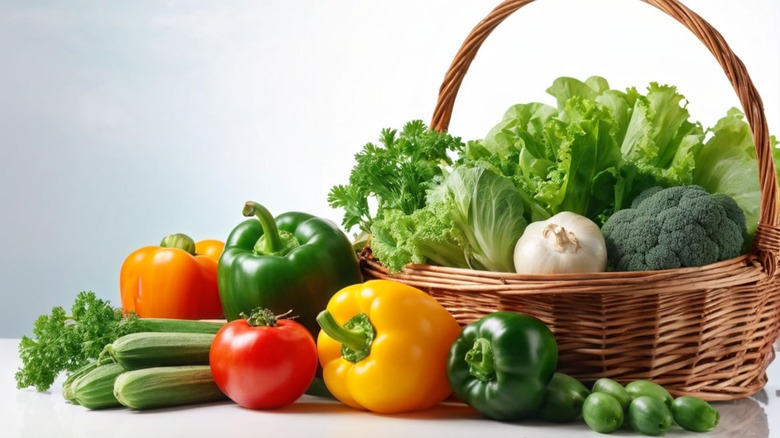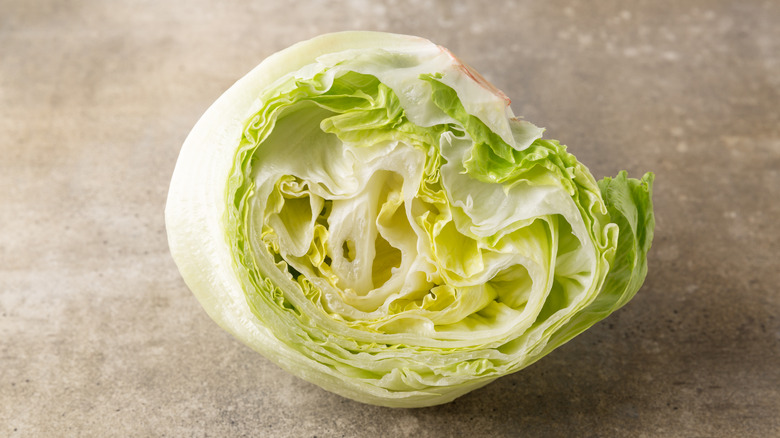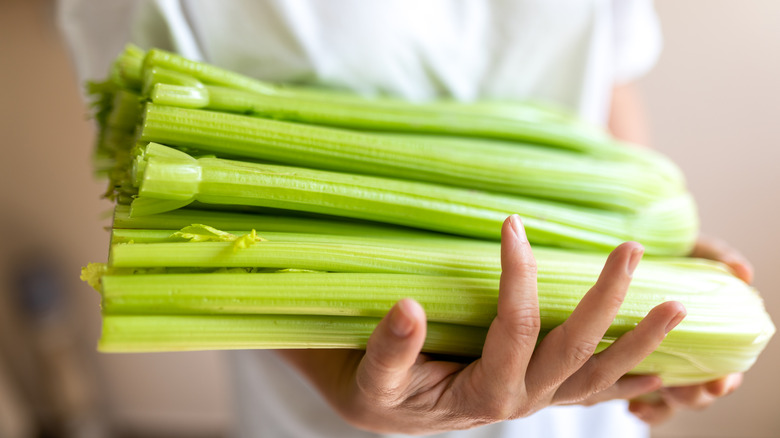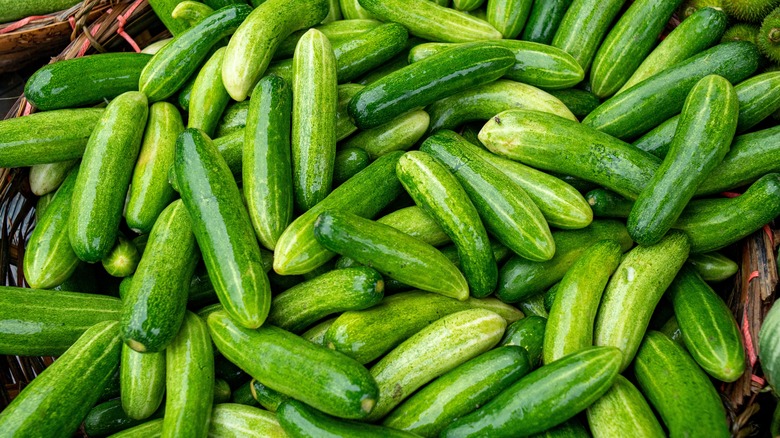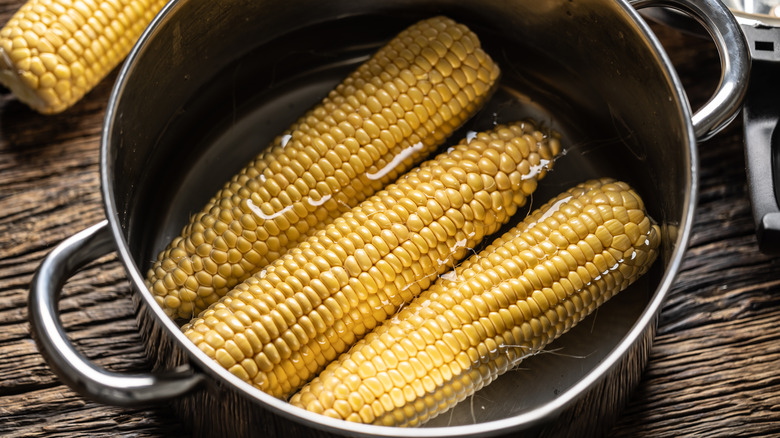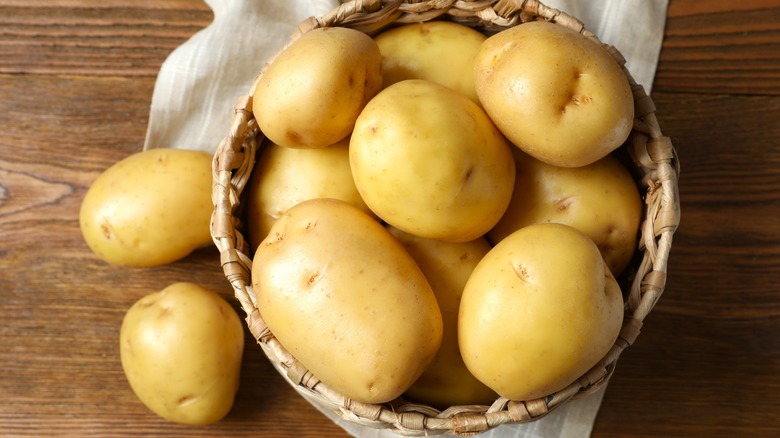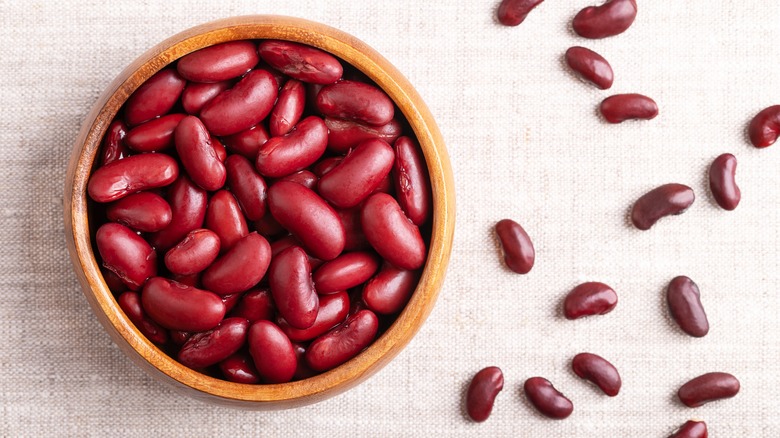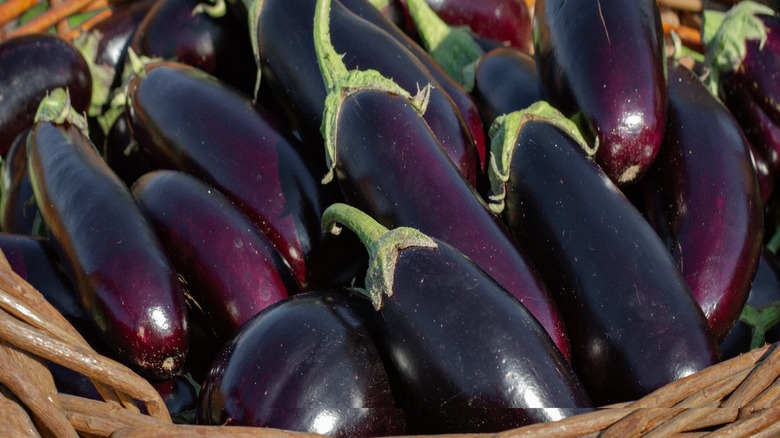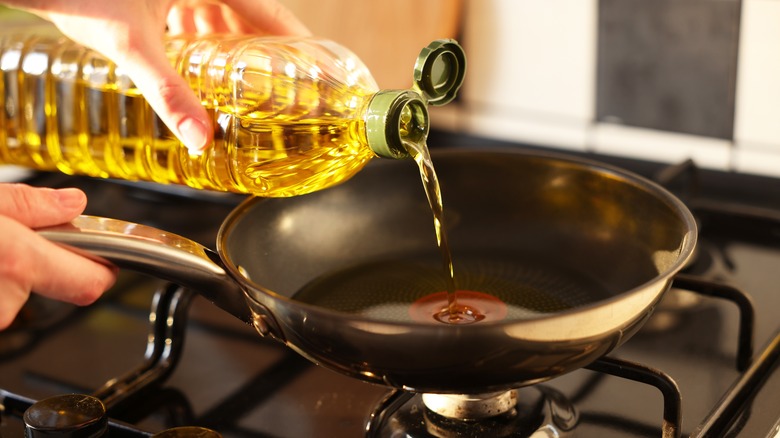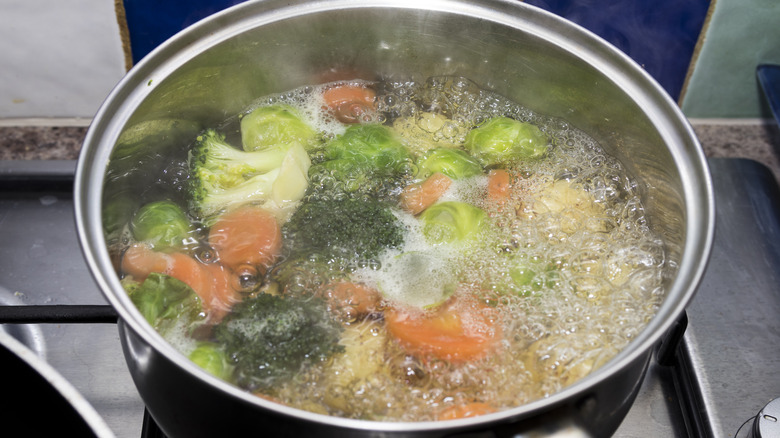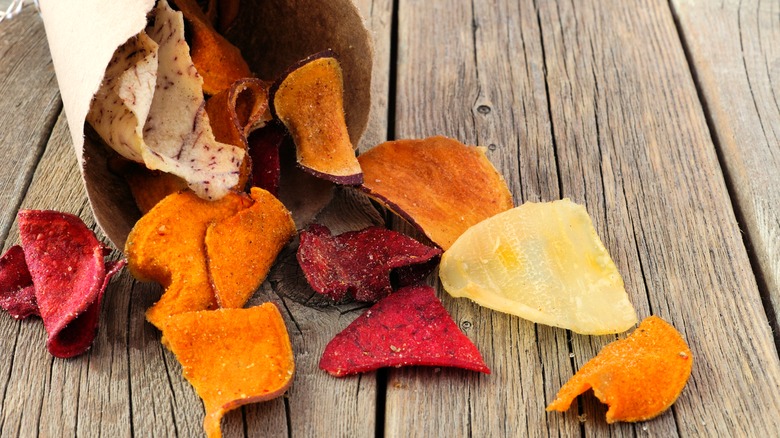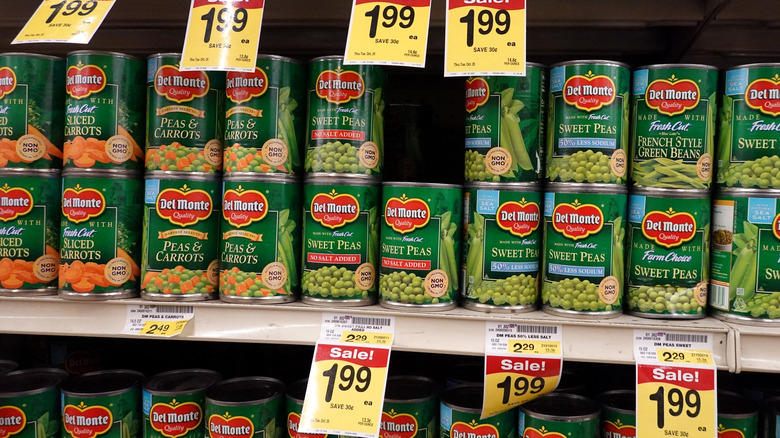Nutritionists Give Us Vegetables (And Cooking Methods) That Aren't As Healthy As We Thought
We may receive a commission on purchases made from links.
When you think of a healthy diet, you probably imagine lots of lush, leafy greens and a colorful cornucopia of fruits and vegetables. Just about everyone can agree that vegetables are one of the staples of a healthful, nutritious diet. However, that doesn't mean that all vegetables are serving up plenty of the good stuff. While, yes, some have achieved "superfood" status and offer a bounty of vitamins, nutrients, antioxidants, and the like, others are a little lackluster. They might not be unhealthy, but they're definitely not as healthy as you might've assumed.
To learn more, we spoke with three experts in the field: Lena Bakovic, registered dietitian nutritionist with Top Nutrition Coaching; Deloris Gibson, registered dietitian and diabetes educator at Penn Highlands DuBois Diabetes & Nutrition Wellness Center; and Danielle Michael, nutrition services director at Encompass Health of Nittany Valley. Here are their thoughts on the vegetables that might not be as healthy as you think, and how you can get the most benefits from every crunchy bite of veg you consume.
Iceberg lettuce
Oh, iceberg lettuce. You're the basis of so many restaurant and fast-food salads. You appear atop tacos and burgers. You're cheap and available at every grocery store. You offer a slight crunch when fresh, but quickly turn slimy and sad when left in the crisper drawer past your prime. All this to say: Iceberg lettuce shouldn't necessarily be your go-to vegetable for every single meal, and it's all because iceberg lettuce is about 96% water content — and not much else. That's great if you're looking for a high water-content food, but bad if you want a vegetable high in vitamins and minerals.
"It is low in calories, but also low in vitamins and minerals when compared to other leafy green vegetables," says Deloris Gibson, registered dietitian and diabetes educator. "It does contain some calcium, potassium, and vitamin A." That said, if your diet is pretty low in vegetables overall, you couldn't do wrong by adding some iceberg lettuce to your plate. Gibson adds, "Eating more vegetables is a great approach to improving the quality of someone's meal plan, and a key piece of advice I usually give all patients. Often, I will say, if you do not know what to do, eat more vegetables!"
Along the same lines, Danielle Michael, nutrition services director, says, "Kale, spinach, or any of the dark leafy greens provide the most nutritious benefit, but if you only like iceburg lettuce, it is better to have that in a salad than no salad at all."
Celery
Similar to iceberg lettuce, celery is pretty chockfull of water and, according to Lena Bakovic, registered dietitian nutritionist, while it's a good source of fiber, that's pretty much all it's going to give you. Beyond just not offering a lot of benefits, celery has also been wrapped up in a myth that could lead to an unbalanced diet.
Somewhere along the line, diet culture began promoting the idea that celery is a "negative calorie" food. In other words, the process of eating and digesting celery supposedly burns more calories than are in the celery. This means, when you eat the celery, you're not only abating your hunger; you're actually burning off some of the calories you may've consumed earlier in the day. However, this is a myth. Studies have found that just chewing burns very minimal calories — only about 11 if you continuously chew for an entire hour. Meanwhile, two stalks of celery has about 15 calories, and you're certainly not going to be chewing one single stalk of celery for an hour or more.
Additionally, eating celery in large quantities (such as if you're trying to take advantage of the "negative calorie" myth) could be harmful to your health. Celery contains toxicants that may harm your skin or liver, when consumed in large quantities.
Cucumbers
Another vegetable with a lot of water content and few overall calories, cucumbers are often paired with iceberg lettuce on simple salads. They admittedly make a great snack. Despite this, Lena Bakovic, registered dietitian nutritionist, counted cucumbers among her top, surprising vegetables that offer the least nutrients and health benefits. She says, "One of the first vegetables that comes to mind and which may surprise people are cucumbers! Cucumbers do offer some nutritional value in that they have a high water content and contain dietary fiber (especially in the skin of the cucumber), but in comparison to other veggies, they are low in vitamin and mineral content."
So, if you want to enjoy your cucumbers, certainly do, but leave the skin on, so you get that extra fiber. Otherwise, take a tip from Bakovic and add more colorful vegetables to your diet. The nutritionist told us the more colorful the vegetable (in general) the more likely it is to offer higher nutritional value. So, for example, if you're building a salad, rather than relying on the pasty and pale iceberg lettuce paired with your cukes, reach for deep green options, like spinach, kale, bok choy, and swiss chard.
Sweet corn
According to dietician and nutritionist Lena Bakovic, corn is among the starchy vegetables that some individuals may want to limit due to their carbohydrate content — particularly those living with diabetes, as the extra carbs can increase blood sugar. Danielle Michael, nutrition services director at Emcompass Health of Nittany Valley, similarly pointed out that corn has the same amount of carbohydrates as bread and other starches, and about triple the carbohydrates that you'll find in other vegetables.
If you're not among those groups of people who need to limit their carbs, you may still want to enjoy sweet corn every summer — and it's not like your body won't appreciate corn's other, more beneficial content beyond the carbs, such as the potassium, folate, fiber, and vitamin C. However, as you prepare the corn, be careful not to make your cob of corn a fatty and calorie-rich side dish — which many people do. Salt and butter quickly add up. Just a single tablespoon of butter contains more than 100 calories and nearly 40% of your recommended daily recommended fat intake. Meanwhile, 1 teaspoon of salt contains 2,300 milligrams of sodium – your entire daily recommended allotment.
Potatoes
You may have heard that it's possible for humans to live off a diet of exclusively potatoes. This theory is sometimes credited to the historical Irish diet that was largely potatoes, or to the fact that a typical potato contains all essential amino acids. However, living off potatoes alone is not so healthy, so don't make the mistake of overestimating this tasty tuber's power. You'd have to eat a massive amount of potatoes every day to get enough calcium and protein.
Additionally, as our experts point out, potatoes, just like corn, are high in carbohydrates, so they can likewise cause blood sugar to spike. They contain as much carbohydrates as bread and other starches, with triple the amount of carbohydrates as other vegetables. That said, you don't need to avoid potatoes by any means — just don't make them your entire diet. As Deloris Gibson, registered dietitian and diabetes educator at Penn Highlands DuBois Diabetes & Nutrition Wellness Center, says of starchy vegetables "... focus on controlling your portion size and limiting how many carbohydrate portions you are consuming as an approach to adjust your meal to meet your meal plan goals."
And just as is the case with corn, avoid adding tons of fat or sodium to your potato — for example, piling a baked potato with butter, cheese, salt, and bacon. You also don't want to limit your potato consumption to eating fried potato products like french fries only.
Undercooked beans
The key word here is "undercooked." Because in general beans are fantastic — they're super-affordable, they can last a long time in storage (in your pantry, for instance), and beans come with many health benefits. Depending on the type of beans you're eating, you could easily get not only fiber and protein, but also a good chunk of other nutrients, such as iron, magnesium, potassium, and phosphorous. So how exactly are these legumes not as healthy as you thought?
Well, it all comes down to something called lectins. Lectins can prevent nutrient absorption, damage your digestive system, or even outright poison you. Some beans are particularly high in lectins, including kidney beans and soybeans. The good news? Cooking these beans thoroughly can mitigate the high lectin levels. So, just make sure you're cooking the beans until they're completely done.
Dietician and nutritionist Lena Bakovic says, "The nutritive benefits of lectin-containing vegetables far outweigh any negative implications to health. These are vegetables such as beans and chickpeas, among other legumes. When consumed in extremely high quantities, lectins may pose a toxicity risk; however, when cooked, lectins are thoroughly degraded. Lectin-containing vegetables are high in nutritive value in that they contain dietary fiber and antioxidants among other vitamins and minerals."
Nightshade vegetables
If you're dealing with some tummy troubles, you may find it helpful to go on an elimination diet. An elimination diet removes certain common foods from you normally eat, then slowly reintroduces them, to help you pinpoint what types of foods are causing you problems. One of the most common groups of foods often analyzed during this process are nightshade vegetables.
Nightshade vegetables include eggplants, potatoes, peppers, and tomatoes. These vegetables are often considered healthful, even if some, like potatoes, have certain risk factors. For example, some individuals with certain ailments, such as IBS, IBD, or arthritis, say that eating these vegetables comes with extra inflammation. However, Lena Bakovic, dietician and nutritionist, explains this won't be the case for every person with autoimmune conditions. For most individuals, they can keep eating them and be totally fine. You just want to be aware of how you feel after eating eggplants and other nightshade vegetables.
If you suspect certain vegetables are making you feel worse (nausea, fever, headache, and diarrhea, for instance) stop eating them. Danielle Michael, nutrition services director at Emcompass Health of Nittany Valley, says, "If someone thinks they have intolerances to certain foods, they should keep a journal of GI trends, and if they see them occur when they are eating these foods, avoid them."
Deep-fried vegetables
It's not just certain vegetables that aren't as healthy as you think. In some cases, it's vegetables that have been cooked a specific way that make them less healthy. For example, when you think of various cooking methods that could be unhealthy, you probably think of frying. But do you realize just how much frying negatively impacts your veggies' health benefits? And the extra fat that soaks into the vegetables when cooking isn't the only issue. Danielle Michael, nutrition services director, says, "Deep frying or sautéing veggies in heavy butter [or] oil will take away the nutrient benefits and add extra unnecessary calories — so this method should only be used for special occasion."
One study found that deep-frying vegetables can reduce the amount of beta carotene in the vegetables by double, as compared to the nutrient loss that would occur with shallow frying. The same study also found that frying cabbage led to a 29% loss of beta carotene, and a 24% loss of vitamin A (as compared to a 14% loss of vitamin A when the cabbage was boiled); meanwhile, frying vegetables like asparagus, Swiss chard, cauliflower, and peppers led to a loss in antioxidant activity ranging from 5% to 40%. In short, if you want to get the most nutrients possible from the vegetables in your diet, leave the deep fryer out of the equation.
Over-cooked vegetables
So if you're thinking about all the cooking methods for your vegetables — that would be overall healthiest — you might go simple, with a no-fat option like steaming or boiling. However, even that comes with a word of caution. While generally healthy, if you happen to overcook your vegetables when steaming or boiling them, you could lose more nutrients than you'd expect.
Lena Bakovic, registered dietitian nutritionist, says, "Methods such as boiling and steaming, if done for extended periods of time, can remove some of the nutrient value of vegetables, particularly the water-soluble B vitamins and vitamin C." Minerals, specifically phosphorous, potassium, magnesium, iron, calcium, and zinc, can also be impacted significantly, with losses of up to 70% of the mineral content in some cases.
And here's a tip: Use less water if you want to steam or boil your vegetables. Deloris Gibson, registered dietitian and diabetes educator at Penn Highlands DuBois Diabetes & Nutrition Wellness Center, says, "Some vitamins [and] minerals will leach out into water. If you cook the food in water and then throw the water out, then some of the nutrients are lost. To help limit the nutrients lost, minimize the amount of water or liquid used during cooking."
Vegetable chips
Bad news, snackers. You might think those veggie chips are full of veggie goodness, but that's not necessarily the case. Danielle Michael, nutrition services director at Emcompass Health of Nittany Valley, explains that if you're eating vegetable chips and straws, you're not getting the same nutritional benefits that you'd get by simply eating the real deal. There are many things unhealthy about vegetable chips. Most are deep-fried, so you get the added fats and nutritional loss that comes with deep-frying a vegetable. Some are mostly potato-based, just like a potato chip, but have just enough of another vegetable added in (via an ingredient like a tomato paste) to call it something other than a potato chip.
For example, if you look at Sensible Portions' Garden Veggie Wavy Chips, you'll see that the first ingredient is potato flour, followed by oil, several starches, sugar, and salt. It's not until the seventh and eighth ingredients that you get dehydrated spinach and tomato. A serving of the chips come with 10% of your daily sodium and 9% of your daily fat, and with no vitamins whatsoever.
However, while eating vegetable chips may not be as healthy as eating an actual vegetable, they are still usually more healthy than eating potato chips, as they often have less sodium and more fiber.
Canned vegetables
Canned vegetables are a great option for those who are seeking to add more vegetables to their diets, but who want a cheap, shelf-stable alternative to fresh vegetables. And, as Lena Bakovic, registered dietitian nutritionist, says, "The standard American diet is low in vegetable content; therefore, any type of vegetable intake is better than none."
However, there is one little surprising thing tagging along in your canned vegetables: salt. A cup of canned vegetables has about 450 milligrams of sodium. That's nearly a fourth of the sodium you should be consuming per day, according to national dietary guidelines. You can rinse your canned vegetables, which will reduce the sodium content by 9% to 23%, according to one USDA study, but the study also found that doing so likewise washes away some of the vegetables' nutrient content — up to 28% of the vitamin C found in green beans and corn, for example. Your best bet is to buy no salt-added canned vegetables. Of course, some vegetables are better than no vegetables.
"I think most people struggle with eating vegetables," says Deloris Gibson, registered dietitian and diabetes educator at Penn Highlands DuBois Diabetes & Nutrition Wellness Center. "There is so much advice, some good, some bad, and some is just marketing to influence how we spend our hard-earned money ... There are a lot of factors that influence people's choices — health issues, food intolerances, taste preferences, supply chain issues, affordability, seasonal availability, market selection, and cost ... Just eat some vegetables!" Gibson encourages you to eat 3 cups of vegetables every day, and you can help accomplish that by making half of your plate vegetables.
